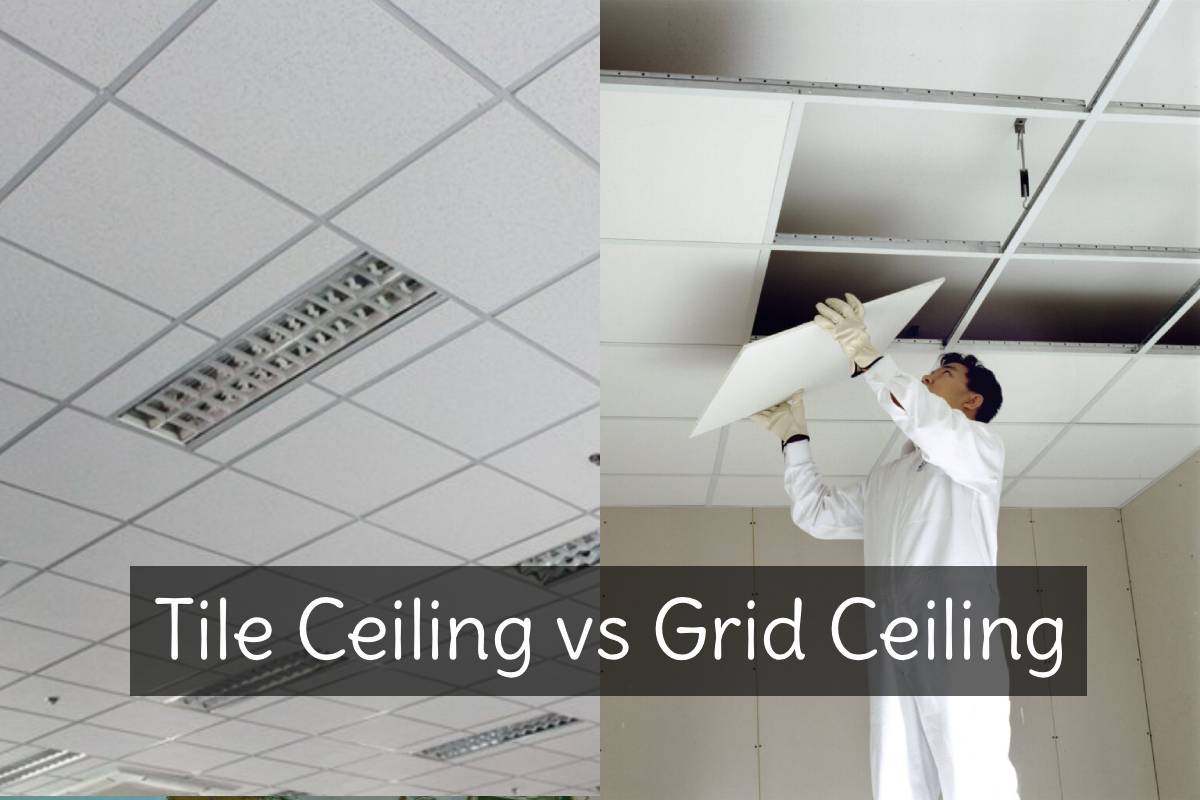When planning or renovating an interior space, ceilings are often overlooked — yet they play a crucial role in aesthetics, acoustics, insulation, and even energy efficiency. Two of the most popular ceiling options for commercial and residential buildings are tile ceilings and grid ceilings. While these terms are often used interchangeably, they refer to slightly different systems, and each comes with its own advantages and drawbacks.
In this article, we’ll take a detailed look at what distinguishes tile ceilings from grid ceilings, how they perform in different environments, and which one might be better suited for your project.
You might also read:
Understanding Tile Ceilings
Tile ceilings, sometimes referred to as drop ceilings or false ceilings, are made up of pre-manufactured tiles fitted into a metal or wooden framework. These tiles are available in a range of materials such as gypsum, mineral fibre, PVC, or even wood.
The main idea behind a tile ceiling is to create a secondary ceiling below the actual structural ceiling. This design not only conceals wires, ducts, and pipes but also allows easy access for maintenance or repairs.
Common materials used in tile ceilings include:
- Mineral fibre: Lightweight and sound-absorbing, ideal for offices or schools.
- Gypsum: Smooth and paintable, suitable for residential and commercial settings.
- Metal or aluminium: Durable and moisture-resistant, often used in hospitals and kitchens.
- PVC: Budget-friendly and waterproof, ideal for bathrooms or industrial spaces.
Understanding Grid Ceilings
A grid ceiling is a type of suspended ceiling system that uses a visible metal framework, or grid, to support panels or tiles. The term “grid ceiling” typically refers to the framework rather than the tiles themselves — it’s the structure that holds everything in place.
In a grid ceiling, T-shaped metal runners form a pattern of squares or rectangles (usually 600 x 600 mm or 1200 x 600 mm), and tiles or panels are dropped into these openings. The result is a clean, modular look that’s common in offices, retail stores, and institutional buildings.
Common grid ceiling finishes include:
- Exposed grid: The most common type, where the grid framework is visible and forms a neat border around each tile.
- Concealed grid: A more seamless finish where tiles hide the supporting grid, giving a sleek, modern appearance.
- Semi-concealed grid: A hybrid option where part of the grid is visible for easy maintenance while maintaining a refined look.
Key Differences Between Tile Ceilings and Grid Ceilings
Although tile and grid ceilings share some similarities, they differ in several key aspects — from installation methods to visual appearance and maintenance.
| Feature | Tile Ceiling | Grid Ceiling |
|---|---|---|
| Structure | Tiles attached to a framework (can be concealed or visible). | Uses a metal grid system to suspend tiles below the ceiling. |
| Appearance | Can be flush, decorative, or plain depending on tile type. | Usually modular with a visible grid pattern. |
| Installation | Can be direct-fixed or suspended. | Requires a grid suspension system. |
| Maintenance | Tiles can be removed individually for access. | Similar — tiles can be lifted to reach services above. |
| Cost | Varies by material — gypsum and PVC are cheaper, metal is more expensive. | Often slightly more cost-effective for large spaces. |
| Durability | Depends on material — metal and PVC resist moisture well. | Long-lasting if grid and tiles are properly maintained. |
| Aesthetics | Smooth and modern; can mimic plaster finishes. | Professional and modular; often used in commercial spaces. |
| Acoustics | Acoustic tiles can absorb sound effectively. | Acoustic tiles also available; grid gaps may slightly affect performance. |
Advantages of Tile Ceilings
- Aesthetic Flexibility
Tile ceilings come in a variety of designs, textures, and finishes. Whether you prefer a sleek, modern finish for a corporate space or a decorative texture for a home interior, tile ceilings offer plenty of customisation options. - Easy Maintenance
Since each tile can be removed independently, accessing the ceiling cavity for repairs or inspections is straightforward. - Sound Absorption
Acoustic ceiling tiles made from mineral fibre or perforated gypsum can significantly reduce noise levels — a major plus in offices, classrooms, or auditoriums. - Thermal Insulation
Tile ceilings can help with temperature control, reducing heat transfer from the ceiling and improving energy efficiency. - Fire Resistance
Many gypsum and mineral fibre tiles are fire-rated, offering an added layer of safety in commercial or residential environments.
Disadvantages of Tile Ceilings
- Moisture Sensitivity
Some tile materials, particularly gypsum and mineral fibre, can warp or discolour when exposed to high humidity. - Fragility
Tiles can crack or chip during installation or maintenance if handled roughly. - Cleaning Challenges
Dust and stains can accumulate on textured surfaces, requiring regular cleaning or replacement of tiles.
Advantages of Grid Ceilings
- Cost-Effective Installation
Grid ceilings are relatively quick to install and are ideal for covering large areas. The modular nature reduces labour costs and installation time. - Easy Access to Services
Like tile ceilings, grid ceilings allow easy access to wiring, plumbing, and HVAC systems above the panels — a huge advantage for commercial properties. - Acoustic and Lighting Flexibility
Specialised ceiling panels can enhance sound control or integrate with lighting systems for better ambiance and efficiency. - Durability and Longevity
Metal grid systems are corrosion-resistant and can support a wide range of tile materials, making them a durable long-term investment. - Customisable Layout
You can choose different tile materials, colours, or even mix open and closed grid patterns to suit your design needs.
Disadvantages of Grid Ceilings
- Visible Grid Lines
Some people find the visible grid lines less appealing, as they can make a ceiling look more industrial or less seamless. - Limited Tile Size Options
Standard grid sizes limit flexibility — custom-sized panels are available but more expensive. - Periodic Maintenance
Over time, grid systems can discolour or warp slightly due to humidity or building movement, requiring minor adjustments or repainting.
Which Ceiling Type is Better?
The choice between tile and grid ceilings ultimately depends on your project’s needs, budget, and design goals.
Choose a Tile Ceiling If:
- You want a smooth, seamless finish.
- You prefer decorative or designer tiles.
- You are renovating a home or hospitality space where aesthetics matter most.
- You need better acoustic or thermal insulation.
Tile ceilings are perfect for residential interiors, hotel lobbies, and boardrooms where a refined, cohesive appearance is desired.
Choose a Grid Ceiling If:
- You’re fitting out a large office, retail, or industrial space.
- You need frequent access to ceiling utilities.
- You want a cost-effective, modular system.
- You prefer low-maintenance and long-lasting materials.
Grid ceilings are the go-to choice for commercial buildings due to their practicality, affordability, and adaptability.
Combining the Two Systems
Interestingly, many modern designs blend both systems for a hybrid approach. For example, a grid ceiling framework can support decorative or acoustic tiles, merging functionality with aesthetics. Concealed-grid systems also offer the clean look of a tile ceiling while retaining the flexibility of a suspended structure.
This combination approach allows designers to meet both aesthetic and performance goals — perfect for spaces that demand a balance of style and practicality.
Maintenance and Lifespan Considerations
Both ceiling types require regular upkeep to maintain their appearance and performance. Dust, humidity, and temperature changes can affect tiles and grid systems over time.
- Cleaning: Use a soft brush or vacuum for regular cleaning; avoid harsh chemicals on gypsum or mineral fibre tiles.
- Inspection: Periodically check for sagging tiles, rusted grids, or water damage.
- Replacement: Replace damaged tiles promptly to prevent issues like mould or ceiling collapse.
With proper care, both systems can last 15–25 years or more, making them cost-effective long-term solutions for both homes and businesses.
Cost Comparison
Costs can vary significantly depending on material choice, ceiling height, and design complexity.
- Tile Ceilings:
Expect to pay around $45–$80 per square metre, depending on the material (gypsum being more affordable, while metal or acoustic tiles are more expensive). - Grid Ceilings:
Typically cost between $40–$70 per square metre, with metal grids and standard mineral fibre tiles being the most common combination.
While grid ceilings are often slightly cheaper overall, tile ceilings may provide better long-term value if design aesthetics are a top priority.
Final Thoughts
When deciding between a tile ceiling and a grid ceiling, the best choice depends on your space, design goals, and budget.
If you value style, acoustics, and a seamless appearance, go for a tile ceiling. If you need functionality, cost-efficiency, and ease of maintenance, a grid ceiling will likely serve you better.
For many property owners, the perfect solution might even be a combination of both systems — a concealed grid with decorative tiles that balances beauty and practicality.
Whichever ceiling system you choose, make sure to work with experienced ceiling specialists who can deliver a professional installation that meets safety and aesthetic standards.
For expert advice, design consultation, and quality installation of both tile and grid ceilings, contact Alpha Ceilings and Partitions — trusted specialists in ceiling and partition solutions across Gold Coast & Brisbane.



